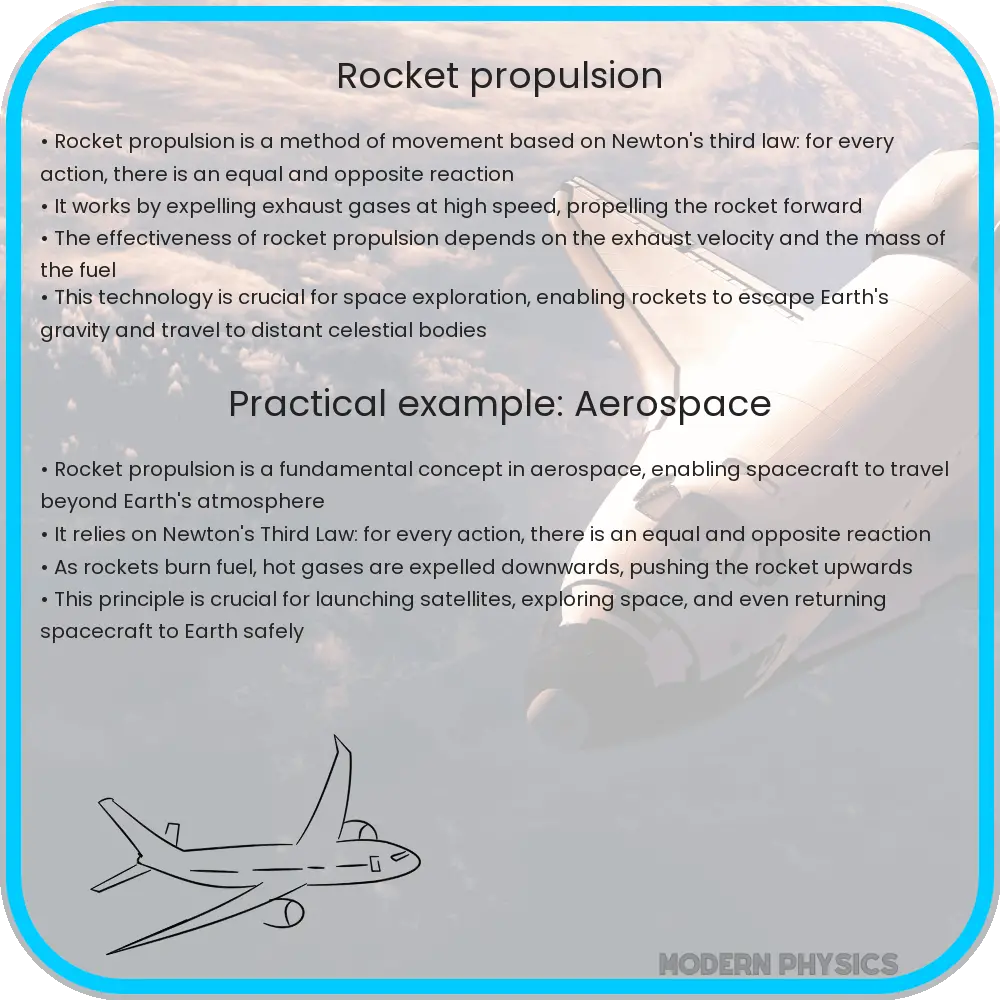Explore the basics, advancements, and future of rocket propulsion, covering thrust dynamics, fuel efficiency, and new technologies in space travel.

Rocket Propulsion: Understanding the Basics
Rocket propulsion is a fascinating and complex field that combines principles of physics, chemistry, and engineering to propel vehicles through space. At its core, rocket propulsion involves the generation of thrust, a force that moves the rocket forward, overcoming gravitational pull and atmospheric resistance. This thrust is produced by the expelling of mass in the form of high-speed exhaust gases from the rocket’s engine.
Thrust and Newton’s Third Law
The fundamental principle behind rocket propulsion is Newton’s Third Law of Motion, which states that for every action, there is an equal and opposite reaction. In rocketry, the action is the expulsion of exhaust gases out of the rocket’s engine, and the reaction is the movement of the rocket in the opposite direction. The thrust force is directly proportional to the mass and velocity of the expelled gases.
Rocket Engine Dynamics
There are two main types of rocket engines: liquid-fuel and solid-fuel engines. Liquid-fuel engines use a combination of liquid oxidizer and fuel, typically liquid oxygen (LOX) and kerosene or liquid hydrogen. The formula for liquid oxygen is O2. Solid-fuel engines, on the other hand, use a mixture of oxidizer and fuel that is pre-packed into a solid form.
The efficiency of a rocket engine is determined by its specific impulse, represented as Isp. Specific impulse is a measure of how effectively a rocket uses propellant and is defined as the thrust per unit weight flow of the propellant. The higher the specific impulse, the more efficient the engine.
Chemical Processes in Rocket Propulsion
Rocket propulsion relies heavily on chemical reactions to generate thrust. In a typical liquid-fuel rocket engine, the oxidizer and fuel are mixed and ignited in the combustion chamber, creating a high-pressure and high-temperature gas. This gas expands and is accelerated through a nozzle, producing thrust.
The efficiency of these reactions is critical. For instance, the reaction between hydrogen (H2) and oxygen (O2) produces water (H2O) and a significant amount of energy, making it a popular choice for many space missions. The balanced chemical equation for this reaction is: 2H2 + O2 → 2H2O.
Understanding the dynamics and efficiency of rocket propulsion is essential for the advancement of space exploration. The ongoing developments in this field continue to push the boundaries of what is possible, enabling longer and more ambitious missions into the cosmos.
Advancements in Rocket Propulsion
Recent years have witnessed remarkable advancements in rocket propulsion technology, aimed at increasing efficiency, reducing costs, and ensuring environmental sustainability. Reusable rockets, exemplified by SpaceX’s Falcon 9, have revolutionized space missions by significantly reducing the cost of access to space. These rockets are designed to return to Earth, land vertically, and be prepared for subsequent launches, a stark contrast to traditional rockets that are discarded after a single use.
Efficiency and Environmental Considerations
Efficiency in rocket propulsion not only pertains to fuel utilization but also encompasses environmental considerations. Traditional rocket fuels, like hydrazine, are highly toxic, and there is a growing shift towards more environmentally friendly alternatives. For instance, liquid methane (CH4) is gaining popularity due to its cleaner combustion and potential for in-situ resource utilization – the ability to manufacture it on other planets like Mars.
Electric and Nuclear Propulsion
Beyond chemical propulsion, there is increasing interest in electric and nuclear thermal propulsion. Electric propulsion, such as ion thrusters, offers higher efficiency by accelerating ions to extremely high velocities. However, they produce much less thrust and are currently suitable only for certain types of missions, primarily those involving small satellites or deep space probes.
Nuclear thermal propulsion, on the other hand, could revolutionize deep space travel. It offers higher efficiency than traditional chemical rockets and can provide sustained high thrust. This technology could significantly reduce travel time to Mars and beyond, though it poses challenges in terms of safety and regulatory approval.
Conclusion
The field of rocket propulsion is at a fascinating juncture. Innovations in reusable rockets, environmentally friendly fuel options, and exploration of alternative propulsion methods like electric and nuclear propulsion are paving the way for a new era in space exploration. These advancements not only promise to make space travel more efficient and sustainable but also open up new possibilities for human exploration and habitation beyond Earth. As we continue to push the boundaries of space technology, the dream of interplanetary travel and colonization inches closer to reality, fueled by the relentless progress in rocket propulsion technologies.
